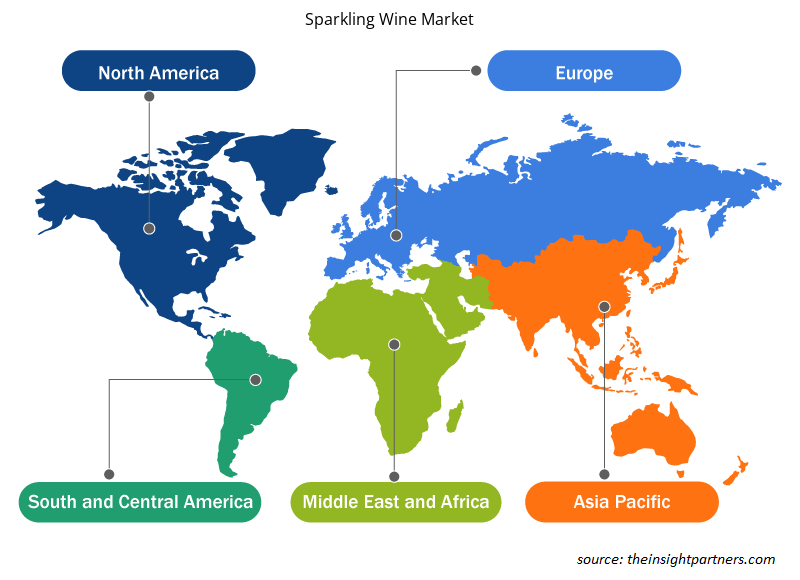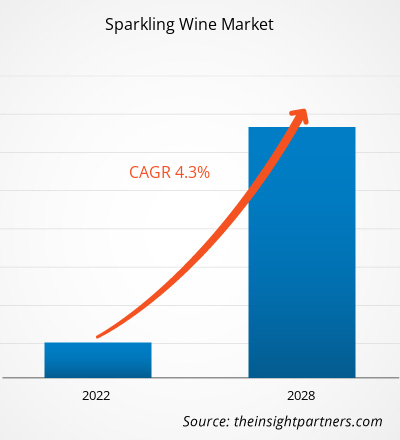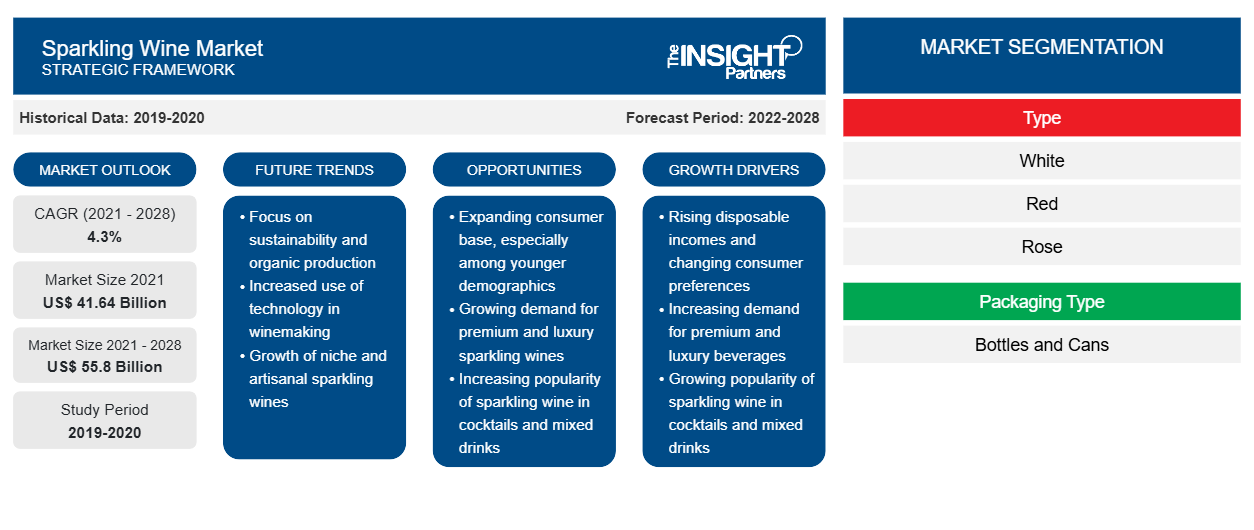Der Markt für Schaumwein hatte im Jahr 2021 einen Wert von 41,64 Milliarden US-Dollar und soll bis 2028 einen Wert von 55,80 Milliarden US-Dollar erreichen; von 2021 bis 2028 wird mit einer durchschnittlichen jährlichen Wachstumsrate von 4,3 % gerechnet.
Schaumwein ist eine Weinsorte mit hohem Kohlendioxidgehalt, die dem Wein zusätzliche Kohlensäure verleiht. Champagner ist eine der beliebtesten Schaumweinsorten. Es handelt sich um den Wein, der in der Champagne in Frankreich hergestellt wird. Viele Schaumweinhersteller in den USA verwenden diesen Namen jedoch für ihre lokal hergestellten Produkte.
Im Jahr 2020 hatte Europa den größten Anteil am Schaumweinmarkt . Die Europäische Union (EU) weist die größte Konzentration von Schaumweinproduzenten auf. Laut dem Institute of Wine and Vine hat die EU seit dem Jahr 2000 einen Anteil von 70–80 % an der weltweiten Schaumweinproduktion. Branchenexperten zufolge exportiert Europa auf die internationalen Märkte mehr Schaumwein als Stillwein. Die Region hat eine lange und ruhmreiche Weinbaugeschichte. Weinliebhaber auf der ganzen Welt bevorzugen europäischen Schaumwein aufgrund seines einzigartigen Aromas, Geschmacks und seiner Herstellungsmethoden. Darüber hinaus rechtfertigen die zunehmende Vorliebe für alkoholarme Getränke, der wachsende Einfluss von Prominenten auf den Lebensstil der Menschen, die Vorliebe für Fertiggerichte und -getränke und die Tradition, bei Festen und Feiern eine Flasche Champagner oder Schaumwein zu öffnen, usw. den dramatischen Anstieg der Nachfrage nach dieser Weinkategorie. Europa verfügt über einen sehr etablierten Schaumweinmarkt, der aus mehreren namhaften und kleinen Destillerien besteht.
Schaumweinhersteller waren während der COVID-19-Pandemie stark von der knappen Verfügbarkeit von Arbeitskräften betroffen, was ihre Produktionskapazität beeinträchtigte. Darüber hinaus zwang die Schließung der Großhandelsmärkte die Hersteller dazu, sich beim Verkauf ihrer Schaumweinprodukte hauptsächlich auf Supermärkte und E-Commerce-Händler zu verlassen. Trotz der Pandemie gab es einen Anstieg der Verkäufe von Rosé- und Schaumwein.
Passen Sie diesen Bericht Ihren Anforderungen an
Sie erhalten kostenlos individuelle Anpassungen an jedem Bericht, einschließlich Teilen dieses Berichts oder einer Analyse auf Länderebene, eines Excel-Datenpakets sowie tolle Angebote und Rabatte für Start-ups und Universitäten.
-
Holen Sie sich die wichtigsten Markttrends aus diesem Bericht.Dieses KOSTENLOSE Beispiel umfasst eine Datenanalyse von Markttrends bis hin zu Schätzungen und Prognosen.
Markteinblicke
Steigende Beliebtheit von Sekt
Schnelle sozioökonomische Veränderungen und eine rasante Urbanisierung beflügeln die Nachfrage nach Schaumwein. Angesichts des kontinuierlichen Anstiegs des Lebensstandards und der Kaufkraft möchten die Kunden hochwertige Luxusartikel erwerben. Darüber hinaus ändern sich mit diesen Veränderungen im Lebensstil auch ihre Essgewohnheiten und Essensvorlieben. Daher steigt die Nachfrage nach Schaumwein bei Partys, Hochzeiten und gesellschaftlichen Zusammenkünften. Mit der wachsenden Vorliebe für Getränke mit geringem oder keinem Alkoholgehalt steigt die Beliebtheit dieses Weins bei Millennials, Teenagern und Berufstätigen sowie bei Junggesellen und Menschen, die in Wohnheimen leben. Darüber hinaus hat die weit verbreitete Nutzung sozialer Medien und des Internets erhebliche Auswirkungen auf alle Generationen, während die steigende Zahl von Partys und gesellschaftlichen Veranstaltungen zum Anstieg des Schaumweinkonsums weltweit beiträgt, vor allem in Industrienationen wie den USA, Kanada, Mexiko, Deutschland, Frankreich und Italien, und so das Wachstum des Schaumweinmarktes vorantreibt.millennials, teenagers, and working populations, and in bachelors and people living in hostels. Furthermore, the widespread use of social media and the Internet is significantly impacting all generations, while rise in number of parties and social events are contributing to the rise in consumption of sparkling wine globally, primarily in developed nations such as the US, Canada, Mexico, Germany, France, and Italy, thereby driving the sparkling wine market growth.
Typ-Einblicke
Der Markt für Schaumwein ist nach Sorten in Rot-, Weiß- und Roséwein unterteilt. Im Jahr 2020 hatte das Weißweinsegment den größten Marktanteil. Weißwein wird aus Moscato Bianco-Trauben aus der italienischen Weinregion Piemont hergestellt. Die Produktion konzentriert sich hauptsächlich auf Alba und die Provinz Asti in Norditalien. Die Bläschen entstehen durch natürliche Gärung, die in der Flasche oder einem großen Tank stattfinden kann. Die Gärung findet statt, wenn dem Wein Zucker zugesetzt wird und Hefe auf den Zucker einwirkt, wodurch Kohlendioxid entsteht. Durch das eingeschlossene Kohlendioxid in einer geschlossenen Umgebung bilden sich im Wein Bläschen.Moscato Bianco grapes from Italy’s Piedmont wine region. Its production is primarily concentrated in Alba and the province of Asti in Northern Italy. The bubbles are caused by natural fermentation, which might occur in the bottle or a big tank. Fermentation occurs when sugar is added to wine and yeast acts on the sugar, generating carbon dioxide. Bubbles are formed in the wine as a result of the trapped carbon dioxide inside an enclosed environment.
Bacardi & Company Limited; Bronco Wine Co.; Casella; Constellation Brands, Inc.; Henkell Freixenet; Chandon; Schramsberg Wineyards; Pernod Ricard Winemakers; The Sparkling Wine Co.; Treasury Wine Estates Ltd; Bottega Spa; Campari Group; und Codorniu gehören zu den wichtigsten Akteuren auf dem Schaumweinmarkt.Casella; Constellation Brands, Inc.; Henkell Freixenet; Chandon; Schramsberg Wineyards; Pernod Ricard Winemakers; The Sparkling Wine Co.; Treasury Wine Estates Ltd; Bottega Spa; Campari Group; and Codorniu are among the key players in the sparkling wine market.
Regionale Einblicke in den Schaumweinmarkt
Die regionalen Trends und Faktoren, die den Schaumweinmarkt im Prognosezeitraum beeinflussen, wurden von den Analysten von Insight Partners ausführlich erläutert. In diesem Abschnitt werden auch die Marktsegmente und die Geografie des Schaumweinmarkts in Nordamerika, Europa, im asiatisch-pazifischen Raum, im Nahen Osten und Afrika sowie in Süd- und Mittelamerika erörtert.

- Holen Sie sich die regionalen Daten für den Schaumweinmarkt
Umfang des Marktberichts über Schaumwein
| Berichtsattribut | Details |
|---|---|
| Marktgröße im Jahr 2021 | 41,64 Milliarden US-Dollar |
| Marktgröße bis 2028 | 55,8 Milliarden US-Dollar |
| Globale CAGR (2021 - 2028) | 4,3 % |
| Historische Daten | 2019-2020 |
| Prognosezeitraum | 2022–2028 |
| Abgedeckte Segmente |
Nach Typ
|
| Abgedeckte Regionen und Länder |
Nordamerika
|
| Marktführer und wichtige Unternehmensprofile |
|
Marktteilnehmerdichte für Schaumwein: Auswirkungen auf die Geschäftsdynamik verstehen
Der Markt für Schaumwein wächst rasant, angetrieben durch die steigende Nachfrage der Endverbraucher aufgrund von Faktoren wie sich entwickelnden Verbraucherpräferenzen, technologischen Fortschritten und einem größeren Bewusstsein für die Vorteile des Produkts. Mit steigender Nachfrage erweitern Unternehmen ihr Angebot, entwickeln Innovationen, um die Bedürfnisse der Verbraucher zu erfüllen, und nutzen neue Trends, was das Marktwachstum weiter ankurbelt.
Die Marktteilnehmerdichte bezieht sich auf die Verteilung von Firmen oder Unternehmen, die in einem bestimmten Markt oder einer bestimmten Branche tätig sind. Sie gibt an, wie viele Wettbewerber (Marktteilnehmer) in einem bestimmten Marktraum im Verhältnis zu seiner Größe oder seinem gesamten Marktwert präsent sind.
Die wichtigsten auf dem Schaumweinmarkt tätigen Unternehmen sind:
- Bacardi und Company Limited
- Bronco Wine Co.
- Casella
- Constellation Brands, Inc.
- Henkell Freixenet
Haftungsausschluss : Die oben aufgeführten Unternehmen sind nicht in einer bestimmten Reihenfolge aufgeführt.

- Überblick über die wichtigsten Akteure auf dem Schaumweinmarkt
Bericht-Spotlights
- Fortschrittliche Branchentrends auf dem globalen Schaumweinmarkt helfen den Akteuren bei der Entwicklung wirksamer langfristiger Strategien
- Von Unternehmen in Industrie- und Entwicklungsmärkten verfolgte Wachstumsstrategien
- Quantitative Analyse des globalen Schaumweinmarktes von 2019 bis 2028
- Schätzung der Nachfrage der Verbraucher nach Schaumwein
- PEST-Analyse zur Veranschaulichung der Wirksamkeit der in der Branche tätigen Käufer und Lieferanten bei der Vorhersage des Marktwachstums
- Aktuelle Entwicklungen zum Verständnis der Wettbewerbssituation auf dem Markt und der Nachfrage nach Schaumwein
- Markttrends und -aussichten gepaart mit Faktoren, die das Wachstum des Schaumweinmarktes vorantreiben und bremsen
- Verständnis für Strategien, die das kommerzielle Interesse am Markt untermauern und so den Entscheidungsprozess der Marktteilnehmer unterstützen
- Schaumweinmarktgröße an verschiedenen Marktknoten
- Detaillierte Übersicht und Segmentierung des globalen Schaumweinmarktes sowie seiner Branchendynamik
- Schaumweinmarktgröße in verschiedenen Regionen mit vielversprechenden Wachstumschancen
Schaumweinmarkt nach Typ
- Weiß
- Rot
- Rose
Schaumweinmarkt nach Verpackungstyp
- Flaschen
- Dosen
Schaumweinmarkt nach Vertriebskanal
- Supermärkte und Hypermärkte
- Fachgeschäfte
- Online-Einzelhandel
- Sonstiges
Firmenprofile
- Bacardi und Company Limited
- Bronco Wine Co.
- Casella
- Constellation Brands, Inc.
- Henkell Freixenet
- Schramsberg Weingüter
- Winzer von Pernod Ricard
- Die Schaumwein-Firma
- Weingut Treasury
- Chandon
- Historische Analyse (2 Jahre), Basisjahr, Prognose (7 Jahre) mit CAGR
- PEST- und SWOT-Analyse
- Marktgröße Wert/Volumen – Global, Regional, Land
- Branchen- und Wettbewerbslandschaft
- Excel-Datensatz
Aktuelle Berichte
Verwandte Berichte
Erfahrungsberichte
Grund zum Kauf
- Fundierte Entscheidungsfindung
- Marktdynamik verstehen
- Wettbewerbsanalyse
- Kundeneinblicke
- Marktprognosen
- Risikominimierung
- Strategische Planung
- Investitionsbegründung
- Identifizierung neuer Märkte
- Verbesserung von Marketingstrategien
- Steigerung der Betriebseffizienz
- Anpassung an regulatorische Trends























 Kostenlose Probe anfordern für - Sektmarkt
Kostenlose Probe anfordern für - Sektmarkt